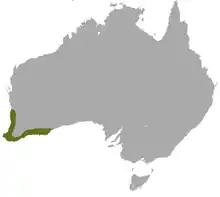| Grey-bellied dunnart[1] | |
|---|---|
| Scientific classification | |
| Domain: | Eukaryota |
| Kingdom: | Animalia |
| Phylum: | Chordata |
| Class: | Mammalia |
| Infraclass: | Marsupialia |
| Order: | Dasyuromorphia |
| Family: | Dasyuridae |
| Genus: | Sminthopsis |
| Species: | S. griseoventor |
| Binomial name | |
| Sminthopsis griseoventor (Kitchener, Stoddart & Henry, 1984) | |
 | |
| Grey-bellied dunnart range | |
The grey-bellied dunnart (Sminthopsis griseoventer), alternately spelled gray-bellied dunnart, was described by the same people Kitchener, Stoddart and Henry along with the Kangaroo Island dunnart, Gilbert's dunnart and little long-tailed dunnart in 1984. They also described the Mallee ningaui in 1983.
The average body length of a specimen can vary between 130–192 mm with a tail of 65–98 mm and body to anus of 65–95 mm. The olive grey ears have a length of between 17–18 mm. The hind feet have an average length of between 16–17 mm. Its weight varies between 15-25 grams.
Distribution and habitat
Found in Western Australia on the coastal south west fringes and associated ranges. From north to south then to east, Gairdner Ranges to Cape Arid National Park, its habitat rarely stretches 100 km (62 mi) inland from the coast. A population was discovered in December 2003 in South Australia during a Department for Environment and Heritage Biological Survey on Eyre Peninsula in the Hincks and Bascombe Well conservation parks. Habitat includes heathy forests, woodland, melaleuca swamplands dense mature heathland. No subspecies is identified.
Social organisation and breeding
Nocturnal species that inhabits leaf litter and burrows. Breeding is done in a nest below ground a few centimetres, with 8 born in August for Boulenger Island and October of other areas. Only 1 litter is born.
Diet
This dunnart is a nocturnal omnivorous marsupial that eats insects, small mammals, reptiles and amphibians as well as soft fruit.
References
- ↑ Groves, C. P. (2005). Wilson, D. E.; Reeder, D. M. (eds.). Mammal Species of the World: A Taxonomic and Geographic Reference (3rd ed.). Baltimore: Johns Hopkins University Press. p. 34. ISBN 0-801-88221-4. OCLC 62265494.
- ↑ McKenzie, N. & Kemper, C. (2008). "Sminthopsis griseoventer". IUCN Red List of Threatened Species. 2008. Retrieved 28 December 2008.
- Menkhorst, Peter W. (1995). Mammals of Victoria. Oxford Press. ISBN 0-19-553733-5.
